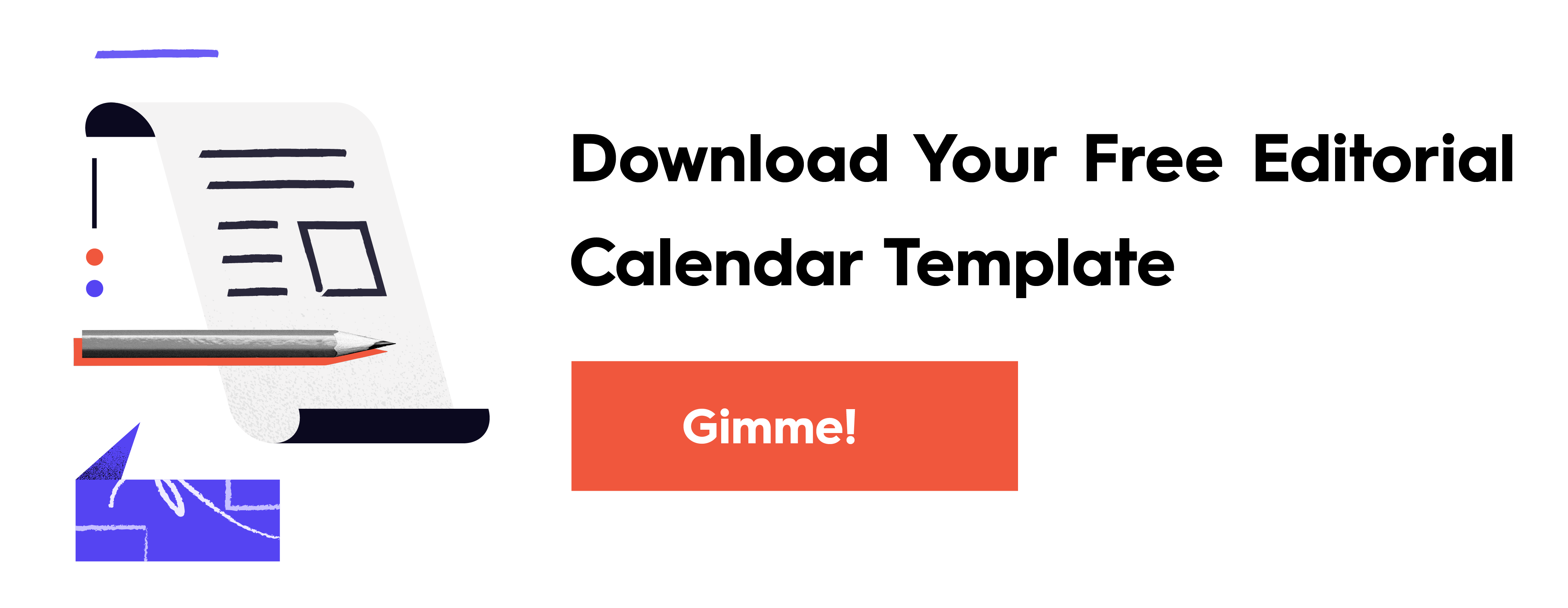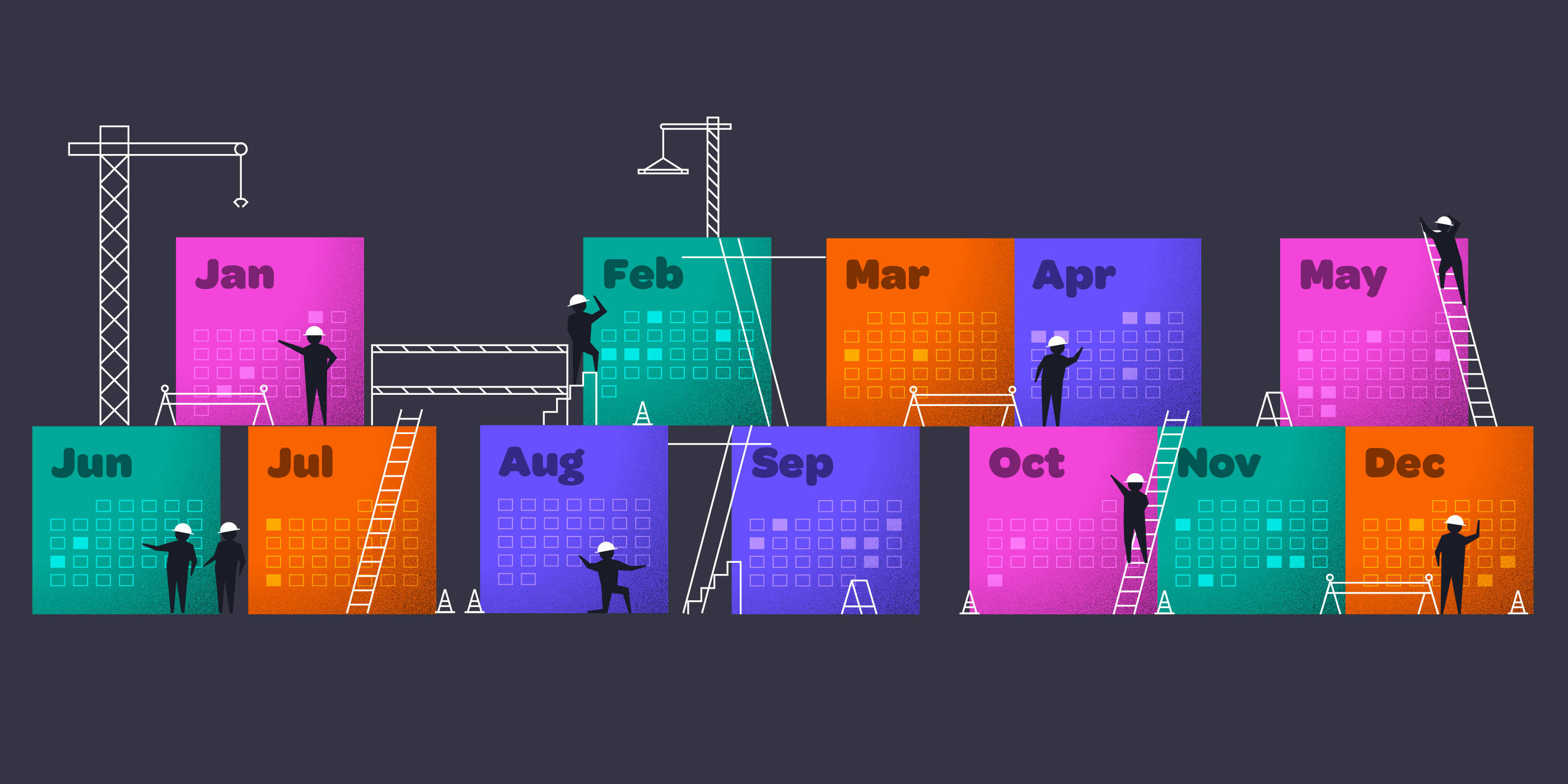Creating good content takes work. From brainstorming and designing to publishing and promoting, there are a lot of moving parts. It isn’t easy to keep everyone on the same page, and it’s damn near impossible if you don’t have a strong strategy, the resources to create good content, and an editorial calendar to keep you on track.
That’s why building and maintaining your editorial calendar is crucial to your success. But how do you create one, and what should it include? We’re here to break it down for you.
Why Do You Need an Editorial Calendar?
No matter how big or small your marketing department is, you need to keep everything organized. An editorial calendar is the best way to do that. By scheduling everything in one place, you can get a bird’s eye view of your content ecosystem and improve your…
- Consistency: To maintain awareness, you need to publish content regularly. That means you need to find the right cadence—and stick to it. Whether it’s daily, monthly, or quarterly, a calendar will help you plan a sustainable publishing schedule that ensures you hit your deadlines. The more consistent you are with your content, the easier it will be to build a relationship with your audience over time.
- Quality: Quality is everything when it comes to content. A calendar helps you better plan for what’s coming up, ensure you have the resources you need, and work ahead so you’re not rushing to get content out the door.
- Accountability: What are you publishing next? What stage of the process is it in? Who’s responsible for it? An editorial calendar helps you keep track of everything in one spot (and, hopefully, prevents people from bothering you with those questions).
Tl;dr, an editorial calendar helps you keep everything together.

What Should an Editorial Calendar Include?
While an editorial calendar provides the same benefits for every brand, not every brand will use the same calendar. Everyone’s needs are different, so you should customize your calendar to make it a truly helpful tool for your whole team. (There’s no point in going to the work to set it up if no one is going to use or manage it.)
That said, whether you’re a small team producing one piece of content a month, or a large team publishing multiple pieces per day, there are basic things you’ll want your editorial calendar to include.
To make things easier, use our Editorial Calendar Template to add, delete, and edit as you see fit.

Note: Depending on your team’s needs, you may also consider using a calendar tool like CoSchedule to manage it all.
Now let’s cover the basics to include.
- Publish Date: This is when content is expected to go live.
- Title: This may be your working title. If you’re publishing content online, you want to make sure your headlines are optimized for SEO (including proper word count, keyword, etc.).
- Format: Specify what type of content you’re creating (e.g., article, infographic, e-book, video, etc.).
- Author: Identify the author or main project manager responsible for creating the content.
- Status: Identify what stage of production the content is in. You can be general (e.g., unassigned, in progress, or complete) or more granular (e.g., unassigned, assigned, first draft, second draft, final edit, approved). Just make sure your team knows what each identifier means.
- Keyword: For digital content, identify the keyword from the jump. This will help your content creators optimize accordingly.
- CTA: This is an important one. You never want people to interact with your content and leave. You always want them to take a next step. Depending on what stage of the buyer’s journey they’re at, that action should be very specific. Do you want people to download an e-book, sign up for a demo, or schedule a sales call? Make sure it’s included in the content. This ensures that every piece of content you create offers a next step.
- Assets: Your content probably includes a visual component, be it an infographic, hero image, visual CTA, video, motion graphic, etc. To make sure all assets are accounted for, include a link to your art.
- Notes: This is the spot to add any additional context, directions, or relevant notes.
Not every calendar needs these things, but if there are additional inputs that would make it easier to manage your content, you can certainly add them. This can include things like….
- Key messaging. If there is particular messaging you want to include (or reinforce), specify what that is to make sure the content communicates it.
- Additional deadlines: If you have a more detailed content process, you may want to keep track of different deadlines for each piece of content (e.g., first draft of copy, final edit round, accompanying art, etc.).
- Personas: Every piece of content should be made for a particular audience. Thus, you can specify who the content is for to ensure you’re speaking to them. (BTW, if your personas need work, see our guide to refine them.)
- More roles: Beyond the author, you may want to specify the project manager, editor, designer, publisher, etc.
- Related links: If you’re publishing a blog, for example, you may want your content to promo additional content (e.g., a specific e-book, guide, or video). While you may use your main CTA to point to these types of pieces, you can also specify related content you want to cross-link to within your article, video description, etc.
How to Put Your Editorial Calendar to Use
Once you’ve set up your basic calendar, it’s time to turn it into a helpful tool.
1) Assign an owner.
If a ton of people are messing with the calendar at once, things can get a little messy. Make sure everyone knows who manages the calendar (or which people are allowed to adjust things). This keeps everything neat and organized.
2) Add holidays, social events, and significant company dates.
The biggest advantage of an editorial calendar is having the foresight to plan ahead, rearrange, and adapt as needed. Make sure significant events are accounted for, as you may need to create content around them (e.g., a major launch) or adjust your publishing schedule to accommodate them (e.g., a holiday weekend).
Pro tip: Forekast is an online calendar that compiles every major holiday and event on the Internet. It’s a great way to identify events that may be relevant to your content calendar.
3) Identify how often you’ll publish.
It might be daily, weekly, monthly, or quarterly—whatever. Just make sure you’re building in enough time to produce content effectively. Remember: Quality over quantity is really what matters. Ten low-value articles probably won’t be as effective as one well-written e-book.
Of course, things will come up and projects may be delayed. That’s why an editorial calendar is so important; you want to fill those gaps to maintain consistency.
4) Know your workflow.
If you want your calendar to be successful, you need to understand who is responsible for what role. That way no task slips through the cracks. In addition to assigning an editorial calendar owner, use our workflow & governance template to outline each stage of content creation and who will be in charge of it.
On that note, here are all the roles you need covered to run a successful content marketing operation.
5) Start scheduling your content.
With a solid editorial calendar, you can start creating and publishing content regularly. To ensure your content is as strong as possible…
- Brainstorm fresh ideas. Follow these tips to hold productive brainstorms, and check out these prompts to come up with great brand stories.
- Vet your ideas through your personas. If you can’t articulate why your idea is interesting or relevant to your target audience, it’s probably not a strong idea.
- Write a good brief. To keep everyone on the same page, use our content brief template to assign to creators.
- Optimize your processes. It’s great if you have a fully scheduled editorial calendar, but if you don’t have the infrastructure or resources to get it done, it won’t do you much good. Follow our guide to master the content creation process to make high-quality content consistently.
You can also consider bringing in expert help. Follow our tips to find the right content agency for you, or find out what it would be like to work with us. We’d be happy to help tell your story.





